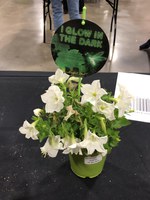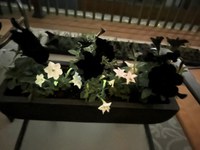Dakota Gardener: Would you buy a glow-in-the-dark petunia?
(Click an image below to view a high-resolution image that can be downloaded)
-

By day, Firefly petunia looks like an ordinary white-flowered bedding plant. (NDSU photo) -

By night, the white flowers of Firefly petunia glow in the dark. The other flowers are standard black petunias. (Photo courtesy of Laura Kourajian) -

Esther McGinnis, NDSU Extension horticulturist (NDSU photo) -

Dakota Gardener graphic identifier (NDSU photo)
By Esther E. McGinnis, Horticulturist
NDSU Extension
An Idaho company released a glow-in-the-dark petunia called Firefly Petunia. By day, the plant looks like an ordinary white-flowered bedding plant. After the sun goes down, the plant reveals its superpower by emitting a faint green glow. While the glow is noticeable, it isn’t bright enough to keep your neighbors awake at night.
Light Bio, Inc., a biotechnology company based in Ketchum, Idaho, inserted genes from a tropical bioluminescent mushroom into a petunia. This genetically engineered plant is special because the glow is visible to the naked eye without using black lights or unusual treatments.
Amazingly, some mushrooms glow in the dark, as do fireflies. To oversimplify, the chemical reaction features a compound called luciferin and the interaction of enzymes, water and oxygen. Both fireflies and mushrooms use bioluminescence to reproduce. For the firefly, the light attracts a mate. Mushrooms glow in the dark to attract nocturnal insects to spread their spores.
Would I feel safe planting a genetically engineered petunia in my flower bed in the northern U.S.? Yes, I would. While working on my Ph.D. in the dark ages, I studied the scientific and legal ramifications of genetically engineered crops and learned how to assess the risk of such crops.
Before this unique petunia came to market, the plant was reviewed by the Animal and Plant Health Inspection Service (APHIS), a subdivision of the U.S. Department of Agriculture. Essentially, APHIS compared the risk of planting an ordinary petunia versus a genetically engineered one. Some factors considered included risks associated with the engineered trait, the potential for the new genes to be transferred to native plant populations, and the potential that the new trait could make the plant invasive or be considered a plant pest.
One aspect considered was whether bioluminescence could pose an ecological risk by confusing nocturnal insects. However, the glow emitted by the petunias is quite minimal compared to street lamps, house lights and landscaping lighting.
Petunia species are native to South America and do not have any close plant relatives in the United States. We occasionally see wild petunia (Ruellia humilis) in the native plant nursery trade. Despite its name, wild petunia is not a true petunia. Common names are funny that way. Therefore, the risk of cross-breeding is non-existent.
Finally, petunias are not invasive and are unlikely to spread into wild areas and get established. This is particularly true in cold climates because petunias are annuals that die with the first hard freeze.
If you decide to purchase Firefly Petunia, plant it in full sun and be patient. The plant may not glow as much when it is small. As it grows, a gardener can make the glow a little brighter by keeping it healthy.
Will I buy a Firefly Petunia plant? Probably not this year – $34.99 for one bedding plant is too rich for my blood. However, I would be game when the prices come down.
NDSU Agriculture Communication – May 21, 2025
Source: Esther McGinnis, 701-231-7406, esther.mcginnis@ndsu.edu
Editor: Kelli Anderson, 701-231-6136, kelli.c.anderson@ndsu.edu

